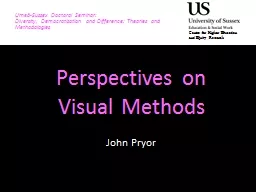

Perspectives on Visual Methods John Pryor Centre for Higher Education and E quity Research Umeå Sussex Doctoral Seminar Diversity Democratisation and Difference Theories and Methodologies ID: 661705
Download Presentation The PPT/PDF document "Diversity, Democratisation and Differenc..." is the property of its rightful owner. Permission is granted to download and print the materials on this web site for personal, non-commercial use only, and to display it on your personal computer provided you do not modify the materials and that you retain all copyright notices contained in the materials. By downloading content from our website, you accept the terms of this agreement.
Slide1
Diversity, Democratisation and Difference: Theories and Methodologies
Perspectives on Visual Methods
John Pryor
Centre for Higher Education and
E
quity Research
Umeå
-Sussex Doctoral Seminar:
Diversity
, Democratisation and Difference: Theories and MethodologiesSlide2
In the beginning Was the word …
… or was it? Slide3
Probable agendaIntroductory presentation (with talkback)Practical activity with taskPlenary session raising issues
Closing thoughts? Slide4
Research and the visualThe visual nature of the world Making understandings of the world through images
Listening only to words is to turn a blind eye to much of the world. Breaking the hegemony of the word as a means of understanding. The materiality of the world
The creative tension between the word and the image : questioning established patterns and breaking the taken-for-granted.
The ‘intrusive presence of the researcher’Slide5
Epistemology The visual and the real – naive triangulation
Objectivity / subjectivity The hidden hand Slide6
Doubled meaning Internal narrative: what is? What is in it?
External narrative: “… the social context that produced the image, and the social relations within which the image is embedded at any moment of viewing” (Banks 2001:11 my emphasis) Slide7
Visual dataPhotographs Videos Drawings Diagrams
Movements, signs Representations of the material world Slide8
Modes and methodsResearcher-recorded data
Objects of the subjectsActive participation
Stimulated response and data chainsSlide9
1. Researcher-recorded data Researcher is recording a social interaction by producing a visual representation – e.g. filming the meeting; photographs of the class in progress
Fixing the complex Recollection in tranquility ‘Naturalistic’Slide10
2. The (visual) objects of the subjectsParticipants are producing visual representations for purposes other than the (self conscious) production of research.
Who is the author of the image? Who is the audience? What are they trying to communicate through their representation? Content and discourse: semiotic analysis Slide11
3. Active participationParticipants are interpreting social situations, events, worlds through actively producing or collecting visual representations
Giving a camera to participants to record their day, video diaries, drawings, mental maps, artefact narrative …Phenomenological ‘Empowering’ - voice,
spontaneous/ reflective, The researcher ‘as witness giving testimony to the lives of others’ (Lather 2007:41)opens up the external narrativeSlide12
4. Stimulated response and data chainsResearcher is collaborating with participants by asking them to interpret visual representations of social interactions,
events, people, objectsSorting, visual (usually photo) elicitation, ‘forensic’ interviews, stimulated video recall,Responses: cognitive, affective, aesthetic, physical
Intertextuality Polyvocality Slide13
Playing with photosHow can you use these photos across the three / four modes and methods:Internal content (1/2):
Who are these people? What are they doing? Why? When? Where?
In whose interest? External narrative (3): what are the processes of selection and composition that lie behind the photos? What were their intentions?
Response (4): How could you use these photos for gaining a response with their authors, subjects or others? How would it be different, if using other media (e.g. video)
What methodological issues does the discussion provoke? Slide14
Stimulated video recall Video-based observation of events and activities provides visual data which may be analysed directly.
After event view with participants generates interview data focusing on: recall of practicesthought processesinterpretation of practicesstatus of practices compared with a norm
resonance with other events. Slide15
Ethics and Visual data Anonymity Sensitivity with participants
Sensitivity with ethics committeesRe-use – requires forethought and persistencePublic data? Slide16
Some other issues with visual data Allowing for genre and aesthetics (often not done with other means) ‘Reactivity’
Storage and archiving Slide17
Reporting with visual data Directness
Academic restrictions (theses, journals) Different strokes … ‘impact’